The Real Benefit of Delofting
We’ve all seen pictures of pros delofting their clubs at impact and many teachers promoting such
technique as good practice. The most cited benefit of delofting is distance gain. E.g. if we take an
8 iron and lean it forward toward the target, the loft of the 8 iron could be reduced to the
equivalence of a 7 iron. This does sends the ball farther. However, have you ever wondered why
they don’t just use a 7 iron and hit it normally? Or why some tour pros talk about delofting even
with their drivers with which one would want to hit up so the ball has enough height and low spin
for maximum distance?
Let’s take a deeper look at the consequences of delofting by comparing two swing sequences
side by side. The pictures on the left side are from a ‘normal’ (non-delofted) swing while the ones
on the right are from a delofted swing. As the club approaches the ball (see below), they look very
similar to each other with the delofted clubhead on the right coming in slightly higher.
technique as good practice. The most cited benefit of delofting is distance gain. E.g. if we take an
8 iron and lean it forward toward the target, the loft of the 8 iron could be reduced to the
equivalence of a 7 iron. This does sends the ball farther. However, have you ever wondered why
they don’t just use a 7 iron and hit it normally? Or why some tour pros talk about delofting even
with their drivers with which one would want to hit up so the ball has enough height and low spin
for maximum distance?
Let’s take a deeper look at the consequences of delofting by comparing two swing sequences
side by side. The pictures on the left side are from a ‘normal’ (non-delofted) swing while the ones
on the right are from a delofted swing. As the club approaches the ball (see below), they look very
similar to each other with the delofted clubhead on the right coming in slightly higher.
At impact (see below) the left wrist is fully unhinged in the ‘normal’ swing on the left. (I.e. the left
arm and the club form a straight line.) The delofted swing on the right retains some angle
between the left arm and the shaft. The yellow lines in both pictures trace the paths of the
clubhead and the two paths look similar. Upon a closer look, you will find that the delofted path is
a bit steeper (i.e. more of a descending blow) into the ball. This is why golfers feel that they ‘trap’
the ball against the ground better when they deloft and the ball comes out with more spin (a benefit
in and of itself).
arm and the club form a straight line.) The delofted swing on the right retains some angle
between the left arm and the shaft. The yellow lines in both pictures trace the paths of the
clubhead and the two paths look similar. Upon a closer look, you will find that the delofted path is
a bit steeper (i.e. more of a descending blow) into the ball. This is why golfers feel that they ‘trap’
the ball against the ground better when they deloft and the ball comes out with more spin (a benefit
in and of itself).


In Depth: Real Benefit of Delofting
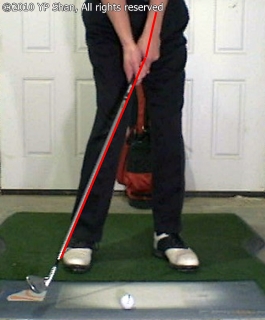

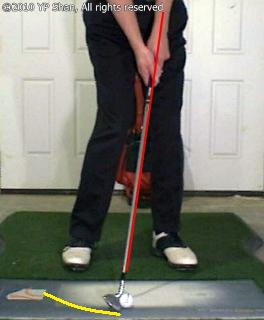
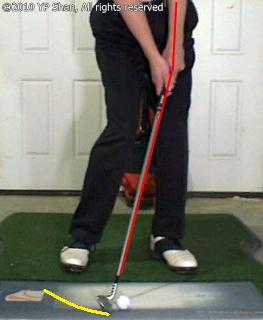
The most revealing pictures are the post-impact ones below. The ‘normal’ swing on the left has a
rounded clubhead path (yellow line) with the low point right at impact. The delofted swing path on
the right is much flatter at the bottom due to the gradual unhinging of the left wrist through the
impact zone.
rounded clubhead path (yellow line) with the low point right at impact. The delofted swing path on
the right is much flatter at the bottom due to the gradual unhinging of the left wrist through the
impact zone.
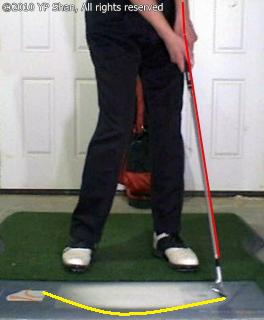
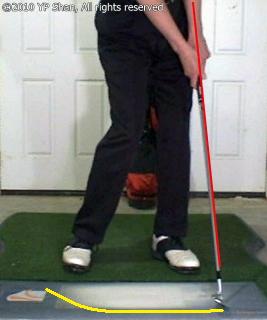
The swing on the left has very little margin of error. If the golfer misses the swing bottom just a
little bit behind or in front of the ball, the result will be a thin or fat shot. The divots from the swing
tend to be deep and narrow. In contrast, the flatter bottom on the right affords a much greater
margin. One can still make a decent contact even if the bottom of the swing is missed by an inch
either way. The divots will also be shallower and longer. Here lies the true benefit of delofting—
greater margin and, thus, easier to make solid contact.
With a driver, although we are no longer hitting down on the ball, a flatter bottom still gives us more
margin to catch the ball on the sweet spot. The only difference is that the flat bottom of a driver will
be angling slightly upward to catch the ball when the clubhead is ascending.
Click the links below to see tour pros demonstrating this in tournament plays.
Sergio: http://www.youtube.com/watch?v=Li9wq33aHeg
Tiger: http://www.youtube.com/watch?v=s0du76ZEd14
http://www.youtube.com/watch?v=vhgfrQoO3Dk
Trevor Immelman: http://www.youtube.com/watch?v=rBosTCApYxI
Sean O’Hair: http://www.youtube.com/watch?v=v7syEPDKm_U
little bit behind or in front of the ball, the result will be a thin or fat shot. The divots from the swing
tend to be deep and narrow. In contrast, the flatter bottom on the right affords a much greater
margin. One can still make a decent contact even if the bottom of the swing is missed by an inch
either way. The divots will also be shallower and longer. Here lies the true benefit of delofting—
greater margin and, thus, easier to make solid contact.
With a driver, although we are no longer hitting down on the ball, a flatter bottom still gives us more
margin to catch the ball on the sweet spot. The only difference is that the flat bottom of a driver will
be angling slightly upward to catch the ball when the clubhead is ascending.
Click the links below to see tour pros demonstrating this in tournament plays.
Sergio: http://www.youtube.com/watch?v=Li9wq33aHeg
Tiger: http://www.youtube.com/watch?v=s0du76ZEd14
http://www.youtube.com/watch?v=vhgfrQoO3Dk
Trevor Immelman: http://www.youtube.com/watch?v=rBosTCApYxI
Sean O’Hair: http://www.youtube.com/watch?v=v7syEPDKm_U